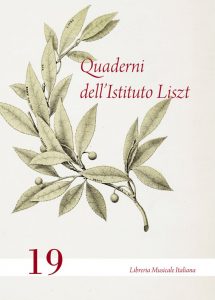SAGGI
Marco Stassi
Continuità strutturale nelle Consolations di Franz Liszt
Nicolò Palazzetti
Béla Bartók, Ferruccio Busoni et la querelle autour de la Gesamtausgabe de Liszt
 AUTOGRAFI
AUTOGRAFI
Annarosa Vannoni
Antonio Sampieri: una vita per la musica
RECENSIONI
Márta Grabócz (éd.), Les grands topoï du XIXe siècle et la musique de Franz Liszt, Hermann, Paris, 2018 (Luca Marconi)
Mariateresa Storino, Franz Liszt a Pisa. Alle radici del recital pianistico tra suggestioni pittoriche e letterarie, Pisa University Press, Pisa, 2018 (Maurizio D’Alessandro)
Luciano Chiappari, Liszt a Firenze e Roma. Nuove ricerche, Edizione dell’Autore, Grisignano (VI), 2015 (Maurizio D’Alessandro)
Bianca Maria Antolini – Annalisa Bini (cur.), Giovanni Sgambati: epigono romantico o musicista dell’avvenire?, Accademia Nazionale di Santa Cecilia, Roma, 2018 (Tiziana Affortunato)
ABSTRACTS
Marco Stassi
Structural continuity in Franz Liszt’s Consolations
The present paper deals with analytical and compositional questions in order to try to test if the six Consolations S172 by Liszt could constitute a unified corpus. The analysis is based on Schenkerian and neo-Riemannian procedures and aims to demonstrate the unity of the six pieces as a general form. The research on the tonalities of the six pieces shows three groups, each made up of two pieces; looking at the final cadences of each piece other clues are discovered. Consolation V – which was the first to be composed – is very important for the general structure of the collection.
Finally, we put the question as to whether the musical language of each Consolation is consistent with that of the other pieces of the collection if they are analysed from other points of view besides those of classical harmony.
Nicolò Palazzetti
Ferruccio Busoni and the dispute over Liszt’s Gesamtausgabe
The artistic and human relationship between Ferruccio Busoni (1866-1924) and Béla Bartók (1881-1945) is fascinating and, at the same time, controversial. Following their first meeting during a piano recital of the Hungarian musician in Berlin in 1903, Bartók and Busoni began a correspondence based on a strong mutual esteem. In a few years, the Italian musician became the mentor of the young Hungarian composer: he wrote several letters of recommendation in his favour, supporting the performances and publications of his music. The peak of this relationship was reached in 1908, when Busoni organised the world première of Bartók’s Fourteen Bagatelles as part of one of his masterclasses in Vienna. In the early 1910s, however, a series of disagreements brought their friendship to an end. This article reconstructs the genesis and development of the short and intense rapport between Bartók and Busoni, and it seeks to clarify the disagreements that slowly damaged it, especially in relation to their 1912 dispute over the Gesamtausgabe of Franz Liszt’s works. To substantiate the narration, detailed information about the correspondence between Bartók and Busoni is provided in a lengthy appendix (ca. fifty letters).
Annarosa Vannoni
Antonio Sampieri: A life in music
The essay takes into consideration a manuscript of a short romance for voice and piano, written by the composer Antonio Sampieri, from Bologna. It has been recently acquired by the Fondazione Istituto Liszt. In the first part, even if the sources are really few, the musician’s biography has been reconstructed. Nobody has so far conducted a research about him, although his musical life was really active. Particular consideration has been given to his controversial aggregation to the Bologna Accademia Filarmonica, along with the reconstruction of his catalogue. It contains the scores which are preserved in the Accademia’s library, donated by the composer himself.
The second part analyses the manuscript both from a bibliographical point of view and from a musical aspect. After a short score analysis, the music is compared with a Sampieri publication with the same title but with a different content. There are also some considerations about the romance and its compositional style at Sampieri’s time, in order to better contextualise the score.